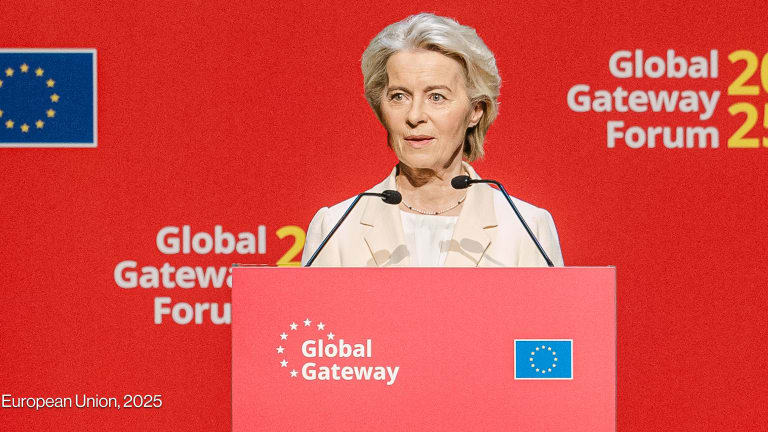Project list reveals EU Global Gateway big on energy, small on health
“Is financing hydrogen production in Chile the appropriate use of EU development assistance?” one expert asked.
European countries will meet Wednesday to endorse a list of 87 mainly climate, energy, and transport-focused investments around the world, designed to compete with China’s Belt and Road Initiative. The Global Gateway, as the European Commission calls its plan, has been lambasted since its launch in late 2021 as largely a repackaging of existing money to fit a new narrative that is more focused on geopolitical posturing and self-interest than the United Nations’ Sustainable Development Goals. The Gateway is based on a promise to leverage at least €300 billion (about $318 billion) in investments globally by 2027, though that figure is achieved by extrapolating from the use of budget guarantees and some grants from the Commission’s development assistance budget, which it claims will encourage private capital to invest as well. NGOs, worried that development staples such as health and education are being lost along the way, will find little solace in the latest list of priority projects — seen by Devex — which includes just seven health projects and three on education. “Social sectors, and education in particular, look like an annex (in terms of number of projects and amounts) to the core focus of [Global Gateway],” Mikaela Gavas, senior policy fellow and managing director of the Center for Global Development in Europe, told Devex by email. Some projects appear big and bold, such as GREGY, an underwater cable connecting Europe to Egyptian solar and wind parks through Greece. However, the relevant “milestone” envisaged this year for that project is the necessary — though arguably less flashy — completion of a feasibility study by the promoter. Many milestones are listed as signatures or “potential signatures” of loans from the European Investment Bank, highlighting the key role for the lender, which will facilitate one-third of the promised €300 billion investment, President Werner Hoyer said this week. In all, the list includes 11 digital projects, 49 on climate and energy, 17 on transport, seven on health, and three on education. Not including some regional initiatives, where not all participating countries are named, some 22 of the world’s 46 least-developed countries are on the list. Many projects, such as the Rogun Dam in Tajikistan, have been under consideration for years. But only those signed after the launch of the Global Gateway in December 2021 will be counted toward the €300 billion commitment. The list of criteria for what counts as a priority “flagship” project, seen by Devex, includes: • respond to the EU’s strategic interests, • respond to a jointly defined need with a partner country or group of countries, • promote EU and/or international principles, standards, and norms, • are consistent with EU policies, such as the Green Deal, • open up economic opportunities for private and public companies, • are already sufficiently mature to produce concrete results “while keeping the flexibility to respond to our partners’ emerging strategic needs”, and • have sufficient financial volume to ensure a transformational effect. Gavas noted that many projects have “a strong link to EU interests,” while others are designed for countries such as Chile, Barbados, Israel, and Uruguay, which are not eligible for foreign aid funding under Organisation for Economic Cooperation and Development rules. “Is financing hydrogen production in Chile the appropriate use of EU development assistance?” Gavas asked. “And at the expense of countries most in need?” The European Commission did not immediately respond to a request for comment.
European countries will meet Wednesday to endorse a list of 87 mainly climate, energy, and transport-focused investments around the world, designed to compete with China’s Belt and Road Initiative.
The Global Gateway, as the European Commission calls its plan, has been lambasted since its launch in late 2021 as largely a repackaging of existing money to fit a new narrative that is more focused on geopolitical posturing and self-interest than the United Nations’ Sustainable Development Goals.
The Gateway is based on a promise to leverage at least €300 billion (about $318 billion) in investments globally by 2027, though that figure is achieved by extrapolating from the use of budget guarantees and some grants from the Commission’s development assistance budget, which it claims will encourage private capital to invest as well.
This story is forDevex Promembers
Unlock this story now with a 15-day free trial of Devex Pro.
With a Devex Pro subscription you'll get access to deeper analysis and exclusive insights from our reporters and analysts.
Start my free trialRequest a group subscription Printing articles to share with others is a breach of our terms and conditions and copyright policy. Please use the sharing options on the left side of the article. Devex Pro members may share up to 10 articles per month using the Pro share tool ( ).
Vince Chadwick is a contributing reporter at Devex. A law graduate from Melbourne, Australia, he was social affairs reporter for The Age newspaper, before covering breaking news, the arts, and public policy across Europe, including as a reporter and editor at POLITICO Europe. He was long-listed for International Journalist of the Year at the 2023 One World Media Awards.








